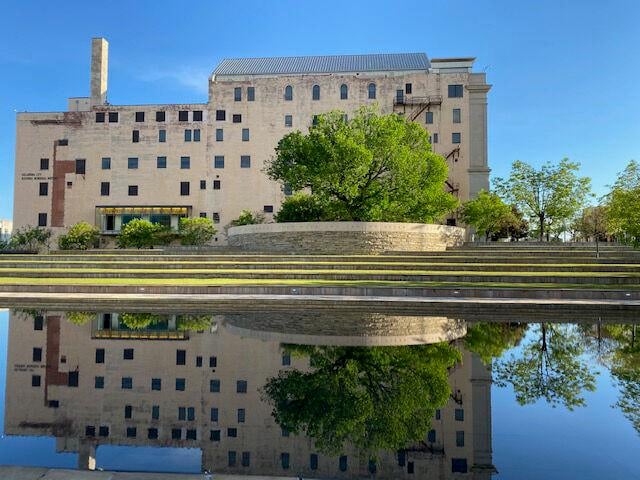
There is always an upset on a trip. A moment when the underdog thunders down the backstretch in dead last and blows by the field in the final furlongs with the favorites fading like old silk.
Oklahoma was that for me. For us. In the 6,000-mile, three-week road trip, if there is an America to be found, we experienced a piece of its heart in Oklahoma.
These are snapshots that lean toward unreliable but of the 24 hours in Oklahoma, 12 of which we spent in Oklahoma City, how do you beat the people, one of whom paid our $1 toll in coins while we were fumbling around at the gate, the great fried blueberry pie from Martha's Noodle & Cake Shoppe in Inola, Okla., bought at a Sinclair gas station or the rolling green hills of an Oklahoma spring? The music gods cooperated too because as we crossed from the Texas Panhandle into Oklahoma, "Oh, What a Beautiful Mornin'" came up on the Spotify playlist as if to say, "Welcome home."
When we entered Oklahoma, the landscape seemed to soften. It was green, pleasing to the eyes and I was glad to leave the harsher Texas Panhandle behind.
I felt like I was returning to my roots even though my people didn't come from Oklahoma. I have no family in Oklahoma and I have no business using roots and Oklahoma in the same sentence, but we live in Bakersfield. Oklahoma is in the water, in the dust and in the music.
It's like owning a mutt in Bakersfield: Odds are, it has some pit bull in it, just like living in the city gives you some Okie blood.
One thing I could use more of is "Oklahoma nice." People smiled, people looked you in the eye when they talked to you, people called me "Sir," and I informed my friends that henceforth I would appreciate it if they addressed me as such.
If we hadn't been impressed with Oklahoma thus far, approaching the OKC skyline did the trick. Modern, plenty of skyscrapers, but not intimidating. The sense was that somebody had thought this thing through and gotten the scale right, one that would welcome rather say, "You might as well turn around and go back to where you came from."
We stayed at the AC Hotel Bricktown. Think industrial chic, think warehouses turned into restaurants, piano lounges and wine bars. Think Eastchester on a grander scale.
The clerk was Oklahoma-friendly and when I asked if it was safe to park the car across the street overnight, she said, "This city is very safe." Not only did she say it but she did so with pride as if she personally would go out at midnight, 2 and 4 a.m. to make sure no one was messing with it.
"Pride" that we saw the next morning on our walk to the Oklahoma City National Memorial and Museum. Where was the litter? The graffiti? Is there anything wrong with clean? I can't think of one thing. Other than an empty lot with a chain-link fence and some tattered paper pinned against it, I only saw one piece of trash, a torn piece of styrofoam in a flowerbed.
"Sometimes we'll have trash when the wind blows," said Cindy, a friendly woman who works for a local hospice, who we met at All About Cha coffeehouse after our walk to the memorial.
The young barista there said, "I find myself picking up trash. People here care how the city works."
Yes, they do and the national memorial was a good example. Memorials are tricky and trickier still to get everybody to agree on a theme that will remind, move and inspire.
This one does. Maybe it's the reflecting pool with the polished black granite, the huge bronze twin Gates of Time on either end of the pool that frame the moment before destruction at 9:01, found on the eastern gate, (representing the last moments of peace), and 9:03 on the opposite or western gate representing the first moments of recovery.
The outside of each gate bears this inscription: "We come here to remember those who were killed, those who survived and those changed forever. May all who leave here know the impact of violence. May this memorial offer comfort, strength, peace, hope and serenity."
Maybe it was the Field of Empty Chairs: 168 chairs hand-crafted from glass, bronze and stone representing those who lost their lives, with a name etched in the glass base of each, which sit on the site where the Alfred P. Murrah Federal Building once stood. The 19 smaller chairs are for the children killed in the bombing and "the three unborn children who died along with their mothers are listed on their mothers' chairs beneath their mothers' names."
"To the courageous and caring who responded from near and far, we offer our eternal gratitude, as a thank you to the thousands of rescuers and volunteers who helped" is inscribed close to a beautiful Oklahoma redbud, dubbed the Survivor Tree. There is something particularly Oklahomian in that voice.
Adding to the impact was the outdoor sculpture across the street called "And Jesus Wept" erected by St. Joseph Catholic Church whose parish house was damaged and demolished in the bombing.
Afterward in the coffeehouse, when we talked to Cindy, we spoke the same language: openness and grandchildren, the universal language. If there were more people like Cindy in the world, we'd be way ahead but Oklahoma is about 10 for 10 on the friendly, welcoming meter.
That's what great about travel. You think you know something about the world, but you may not. Rather than fitting the world into what you think you know, it might make sense to lose the narrow categories and cast your lot into the wind.
May 09, 2021 at 02:15PM
https://ift.tt/3uBRme3
HERB BENHAM: Oklahoma is more than OK by me - The Bakersfield Californian
https://ift.tt/3eCf9lu
Herb
No comments:
Post a Comment